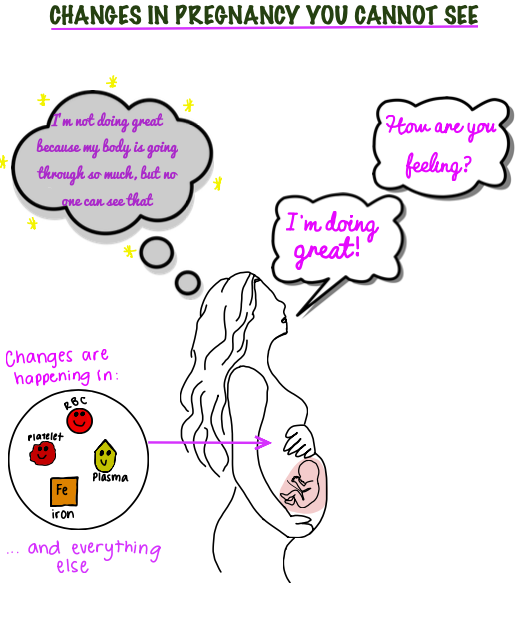The media I decided to use for this project is a digital drawing. I drew an outline of a pregnant woman, portraying a conversation between herself and someone else. The person asks how she is feeling and she responds with great. But in her mind she knows she does not feel great. Oftentimes people only focus on the obvious physical changes (like weight gain or breast changes) that a woman goes through during pregnancy, but there is so much else going on in her body. I put this conversation into the drawing to show that there is more to pregnancy than just the obvious physical ones. I also added little cartoons of a RBC, platelet, plasma, and iron to show some of the many changes that happen during pregnancy. The objective I chose to do this project on was “describe the physiological, hormonal, and physical changes in pregnancy,” but I focused on the physiological ones because they are typically not changes that people often think about.


My peer’s project covered the objective of describing the physiological, hormonal, and physical changes in pregnancy and uses digital art as the media. This project focuses more on the changes within the blood of the mother than some of the other changes that occur during pregnancy. Pregnancy causes changes in many different aspects of a mother’s blood including the amount of red blood cells, hemoglobin, platelets, blood plasma, and iron that is needed to keep both the mother and fetus healthy for the duration of the pregnancy.
During pregnancy a mother creates more blood plasma to sustain adequate circulation to their own body as well as supply oxygen to the fetus and the placenta. This increase in blood plasma prompts the body to create more red blood cells and hemoglobin. Because of this, a pregnant mother will need to ingest greater levels of iron to keep up with the circulatory demand. If the mother cannot sustain the levels of iron needed and is anemic the fetus may not get enough oxygen.
This increase in blood plasma also leads to a lower platelet count, which can be very dangerous since platelets aid in the coagulation of blood around an injury. This is incredibly important for birth, whether it is a natural birth or cesarean. Many mothers who have natural births experience tearing, and in a cesarean there is an incision made to the uterus to remove the baby. In either case proper blood clotting and healing is imperative to keeping the mother healthy after birth, not just during the pregnancy.